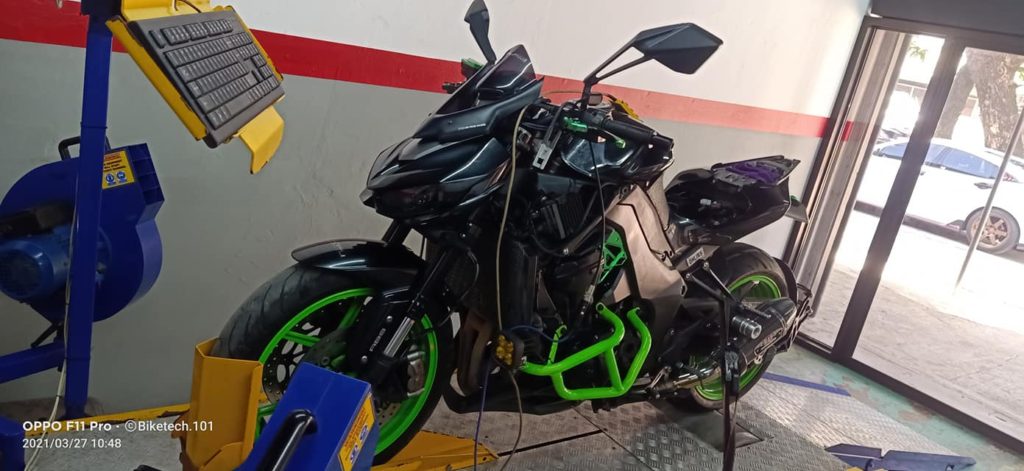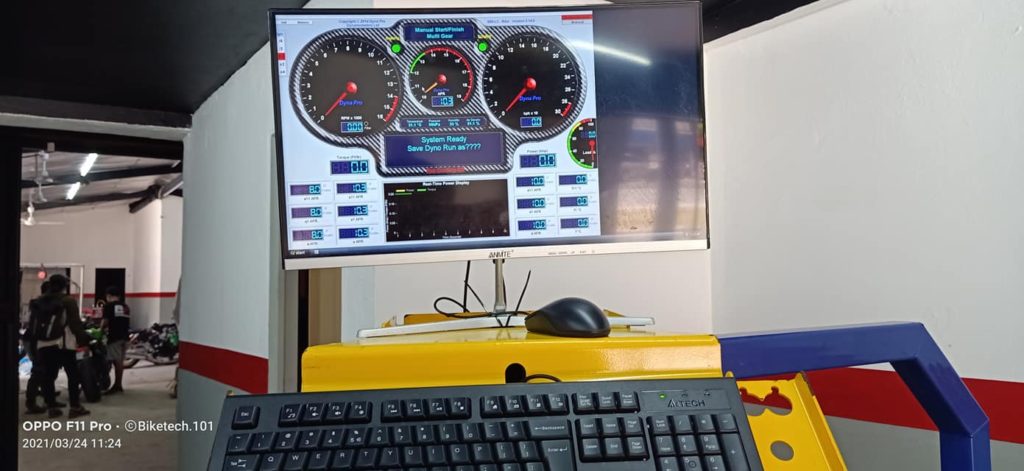Why Dyno Tune your bike?
When you purchase a new motorcycle, your engine’s computer is already tuned to work with the components that came with it. When you modify or change those factory parts, your engine is no longer optimised; the computer map is no longer calibrated to the component(s) on your bike, and you need a new map. This is what dyno testing is all about. If your motorcycle has a new exhaust system, high-performance air filter, or other engine modifications, you will greatly benefit from having fuel delivery and ignition timing that matches the engine’s new characteristics. BikeTech Performance applies most cutting-edge technology available to do just that.
By measuring torque, horsepower, engine RPM, and the air/fuel ratio for your motorcycle, BikeTech Performance creates custom air/fuel and ignition maps that will match your motorcycle’s engine configuration. While many aftermarket electronic fuel injection (EFI) controllers come with a “base” fuel map for your year, make and model of bike, no two engines are alike. Power tuning with the engine under a load on a dynamometer is the only way to ensure optimum performance. Dyno tuning your motorcycle will offer smoother running, better roll-on acceleration, more power and additional fuel efficiency.
The dynamometer has made a huge impact on the industry. Most racing teams use a dynamometer to tune their bikes. These days, you are at a disadvantage if you frequent a shop that does not have a Dyno. It has become the industry standard and a shop without one simply cannot provide the state-of-the-art technology and service that a shop with one can.
What is a Dyno Tune?
The dynamometer measures the horsepower and torque delivered to the rear wheel which is charted on a graph. This graph displays the horsepower and torque through the entire engine RPM range. The technician will use this information to tune the air/fuel mixture and ignition timing for maximum performance. With data collected from a dynamometer the mechanic can actually see if his adjustments increased performance and by exactly how much. This takes the guesswork out of tuning.
What is Horsepower, Torque and Air/Fuel Ratio?
Horsepower is top speed, and torque is what gets us there. Air/fuel ratio is how much air and fuel are mixing and entering the combustion chamber. This is how rich or lean the motor is running. Either end of the scale will cost you power, torque, economy, and efficiency. If you get the balance too far out on the lean side, damage can be done to the motor. If you get unbalanced to the rich side, you can foul spark plugs, dilute your oil with gasoline, and generally cause a noticeable reduction in performance.
All motors produced today that are in legal production have to meet Federal requirements and are generally on the lean side of the scale. Changing exhaust systems, mufflers, air filters, carburettors, and sometimes even spark plugs affect the way a motor performs. While making these changes may seem like the thing to do, one can end up with problems if these are not done properly.
How do I know if I need a Dyno Tune?
For the most part any motor that has had changes made to the intake or exhaust system, is using race fuel, or has any engine modifications will need to be tuned for the components added or changed. It makes no difference if your bike is carbureted or fuel injected, both can be dyno tuned.
Dyno tuning usually requires purchasing a fuel management device or ignition control device. When you combine installing performance parts, a fuel management device, and dyno tuning, you will immensely improve your riding experience.
What options are available for my fuel injected bike?
The most common upgrade for your fuel injected motorcycle or ATV is a fuel management device. A fuel management system plugs in-line with your bikes stock wire harness using OEM style connectors. It allows the tuner to make a full range of adjustments to the fuel system to compensate for rich/lean running conditions which will result in a much smoother running engine, quicker throttle response, and an overall increase in performance. These devices have no effect on your bikes electrical components and once it is removed, the bike reverts to its stock settings. Some of the common fuel management devices available include:
- Woolich Racing (our choice)
- Power Commander
- Many more…
Aside from these add-on devices, there is the option to use the bike manufacturer’s tuning kit. Some kits are a basic handheld device that plugs directly into the stock wire harness. Others use a sub-harness to connect a bike to a laptop. All adjustments are saved in the stock ECU (engine control unit). Using these kits will allow for +/- adjustment of fuel injection and ignition timing at various operating points along the rpm range and throttle position. This degree of adjustability allows the user to take complete control of their engine mapping, enabling the rider to fine-tune the engine to their riding style.
Ignition control devices are available and allow you to make +/- adjustments to the ignition system. Making adjustments to your ignition timing is beneficial for people using race gas, high compression pistons, and performance cams.
The common devices used for ignition control are:
- Woolich Racing
- Vortex
- Power Commander 5 (fuel and ignition control)
- Factory Tuning Kit
Why is a custom map better than a map downloaded from the internet?
There are differences in each motorcycle, even between the same make and model side by side. Maps downloaded off the internet, or installed in a new piece of performance hardware are designed to get you close for your bikes modifications, but that doesn’t take into consideration altitude, ambient temperature, humidity, location, or the differences between each bike. By setting the air/fuel ratio for your specific motorcycle, we can get all your bike has to offer in drivability AND horsepower.


BikeTech Performance benefits
In preparation for testing, every bike must go through the initial stage, the preparation stage.
At BikeTech Performance, we prepare bikes by using a checklist to work from the front of the bike to the rear, identifying each component that has any impact whatsoever on engine performance. These components include:
As part of the preparation stage, we affix customised equipment to the exhaust and other areas of the engine. These sensors and calibrated measurement devices are tuned to detect tiny changes in heat, pressure, and other variables. The preparation stage is critical because it requires the location and placement of all of the sensors that will be sending all of the data back to the central processing computer, which will then, in turn, provide performance calculations.
After the preparation stage comes the testing stage. This stage involves running the motorcycle engine through a series of RPM ranges throughout each gear. Depending on how well the bike shifts and uses fuel to produce power, the readings that are displayed by the computer will vary. During the testing stage, dozens of different performance metrics are captured in real time as the bike is running, hence the term ‘dynamic’ is used to describe this test.


Once the testing stage is satisfactorily completed, the performance analysis stage is next. During the performance analysis stage, the sensor data is compiled and calculated to identify areas of improvement. These areas can include shifting, fuel/air mixture, ignition timing, and much more.
After the performance analysis is complete, it’s time to move on to the modification execution stage. This stage involves making the actual engine changes that will result in enhanced performance for the motorcycle. This is where the expertise of the motorcycle technician will come into play, as every motorcycle is different, and even performance metrics for exactly similar bikes might vary slightly.
For Dyno Testing and Tuning, Contact BikeTech Performance
Only a seasoned motorcycle service professional who knows how to interpret the results of a dyno test is suitable to perform dyno tested engine modifications for a motorcycle. At BikeTech Performance, our staff are expertly trained in the preparation, administration, and analysis of dyno testing. To schedule your dyno test and tune, or to ask about how your motorcycle might benefit from it, contact BikeTech Performance today on 0961 101 6111.
NOTICE:
Any performance items you add to your bike will change the emissions from your motor. This may or may not be legal depending on the state you operate your motorcycle in.
Motorcycle owners should accept that Fuel Management Devices are always at the owners risk. Owners need to ensure they are compliant with any/all applicable laws. Additionally any performance parts you install may affect your warranty.
